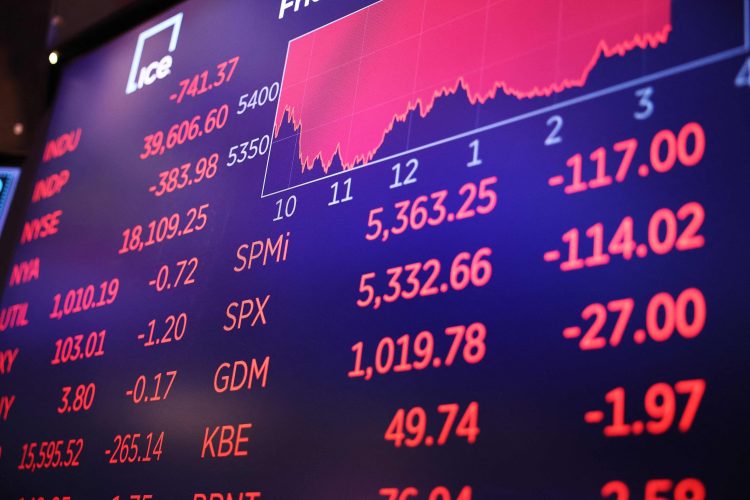Introduction: Navigating the Turbulent Waters of Market Uncertainty
The year 2025 has presented investors with a landscape marked by uncertainty. With rising geopolitical tensions, fluctuating interest rates, and persistent inflation, the global financial environment is more volatile than ever. In such a challenging atmosphere, building a resilient investment portfolio has become a necessity rather than a choice. As markets continue to experience unpredictable swings, investors must adapt by using diversified strategies that ensure long-term growth and stability.
This article aims to provide insights into diversification techniques tailored to current market conditions. We will also incorporate recent market news to offer context for these strategies, ensuring that investors are well-prepared to face the challenges ahead.
Understanding the Current Market Conditions
To build a resilient portfolio, it’s essential first to understand the broader economic environment. Recent developments in monetary policy, global trade, and economic growth have directly impacted financial markets.
- Monetary Policy and Interest Rate Adjustments
The Federal Reserve’s decision to keep interest rates unchanged at 4.25%–4.5% in 2025 is indicative of the cautious stance policymakers are taking in response to inflation and growth concerns. Rising interest rates typically lead to higher borrowing costs, which can slow down consumer spending and economic growth. On the other hand, keeping rates steady may reflect an attempt to balance inflation with economic recovery. For investors, understanding the direction of interest rates is crucial, as it influences both bond yields and stock valuations.
- Global Geopolitical Tensions
Geopolitical instability, particularly between major economies such as the U.S. and China, continues to add uncertainty to the market. Trade wars, supply chain disruptions, and regulatory changes can significantly affect the stock market. Additionally, political uncertainty in Europe, especially surrounding Brexit’s long-term effects, remains a factor that could influence investor sentiment.
- Inflation Pressures and Economic Growth
Inflation remains a significant concern globally. While some central banks have been able to tame inflation somewhat, the long-term effects of price increases are still being felt. For instance, rising energy costs, commodity prices, and labor shortages continue to put pressure on household budgets and business margins. As a result, inflationary pressures may lead to higher market volatility, making it crucial to incorporate inflation-hedging strategies into investment portfolios.
The Role of Diversification in Building a Resilient Portfolio
Diversification is often cited as one of the most effective ways to manage risk in an uncertain market. It reduces the potential for significant losses by spreading investments across different asset classes, sectors, and regions. Let’s break down key diversification strategies that can help investors weather the storm of market uncertainty.
1. Asset Class Diversification
Diversifying across different asset classes—such as stocks, bonds, real estate, and commodities—helps balance the risks and rewards of a portfolio.
- Equities (Stocks): Stocks remain a primary driver of long-term growth, but they are also the most volatile asset class. During periods of economic uncertainty, equities may experience significant price swings. To mitigate this, investors should consider investing in a mix of large-cap, mid-cap, and small-cap stocks, as well as international equities. For example, emerging markets, though more volatile, offer higher growth potential compared to developed economies.
- Bonds (Fixed Income): Bonds, especially U.S. Treasuries, can provide stability and income during periods of market turmoil. In a rising interest rate environment, however, long-duration bonds may lose value. Investors should consider shorter-duration bonds or inflation-linked bonds, such as TIPS (Treasury Inflation-Protected Securities), to mitigate interest rate risk and provide a hedge against inflation.
- Commodities: Investing in commodities like gold, oil, and agricultural products can be a smart strategy during inflationary periods. Commodities often serve as a safe haven when traditional asset classes, such as stocks and bonds, falter. Gold, in particular, is historically viewed as a hedge against inflation and market volatility.

2. Sector Diversification
Different sectors of the economy respond differently to market conditions. By diversifying across sectors, investors can reduce the risk associated with any single industry’s downturn.
- Technology: Despite its volatility, the technology sector offers significant growth potential, especially in areas like artificial intelligence, cybersecurity, and cloud computing. However, tech stocks tend to be sensitive to changes in interest rates, so investors should monitor the Federal Reserve’s actions closely.
- Healthcare and Consumer Staples: These sectors are often seen as defensive because they provide essential goods and services that consumers continue to purchase during economic downturns. Healthcare companies, in particular, offer potential growth due to aging populations and advancements in medical technology.
- Financials: While financial stocks can be sensitive to interest rate changes, they also benefit from rising rates, as banks can charge higher interest rates on loans. However, global economic conditions and regulatory changes may affect their performance. Financials can provide both growth and stability, making them an essential part of a diversified portfolio.
3. Geographical Diversification
Investing in international markets helps reduce exposure to the risks associated with any single country’s economy. While the U.S. stock market remains dominant, emerging markets such as Asia, Africa, and Latin America present unique opportunities for growth. In particular, regions like Southeast Asia have become hubs for innovation and infrastructure development, offering attractive investment prospects.
However, geographical diversification also comes with risks, such as currency fluctuations, political instability, and regulatory changes. Investors should be aware of these risks when diversifying globally.
Incorporating Alternative Investments
Alternative investments—such as real estate, private equity, and hedge funds—can add another layer of diversification to a portfolio. These assets often perform independently of traditional stock and bond markets, providing a buffer during times of high volatility.
- Real Estate: Real estate can offer both income and capital appreciation, making it an attractive investment during uncertain times. Commercial real estate, in particular, may benefit from increased demand in specific sectors like logistics and data centers.
- Private Equity and Venture Capital: Investing in private companies or startups can be risky but offers the potential for high returns. These investments are less liquid and often require a longer time horizon, making them suitable for investors with a higher risk tolerance.
Rebalancing and Regular Portfolio Review
One of the key components of maintaining a resilient portfolio is regular monitoring and rebalancing. Market conditions change, and so should your investment strategy. For example, as interest rates rise, it may be prudent to reduce exposure to long-duration bonds and increase holdings in inflation-hedging assets like commodities. Similarly, if a particular sector is underperforming, shifting investments to other, more stable sectors can help protect the overall portfolio.
Staying Informed: The Importance of Market News
Staying informed about macroeconomic factors, such as changes in central bank policies, global trade developments, and inflation data, is essential for adjusting a portfolio’s strategy in real-time. For example, news regarding China’s economic slowdown or a major geopolitical event could have significant impacts on global markets. Understanding how these events affect different asset classes and sectors allows investors to make informed decisions.
Conclusion: Building for Long-Term Resilience
The key to building a resilient portfolio in 2025 lies in diversification—across asset classes, sectors, and geographies—along with an understanding of current market dynamics. By regularly reviewing your portfolio, staying informed about global economic developments, and adapting your investment strategy to market conditions, you can position yourself to not only weather the storms of market uncertainty but thrive in them.














































